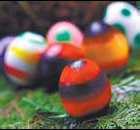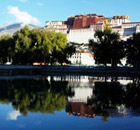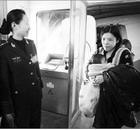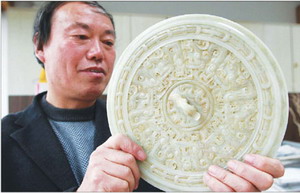Delicacies
Safety before sashimi
(China Daily)
Updated: 2011-04-12 10:22
 |
Large Medium Small |
 |
|
Nadaman Japanese Restaurant sources its seafood ingredients from all over the world. Provided to China Daily |
Salmon from Norway, sea urchin from Dalian in Liaoning province, tuna from Spain, king crab from Canada and bream and snapper from Fujian province - that's how the real supply chain for most Japanese restaurants in China works, thanks to an efficient international and domestic logistics network.
Even the sushi soy sauce, sake and mirin are mostly from local joint ventures that the Japanese set up in the mainland years ago.
As for hamachi, the buttery yellowtail that comes from Japan, diners will just have to go without as fears of radiation contamination cause business at the restaurants to dip - or at least until the sashimi chefs are happy with an alternative supply source.
That's what happening from Hong Kong to Beijing.
Restaurants serving authentic Japanese cuisine are quietly changing the menu, too, and dropping items that cannot be easily replaced. As headlines scream warnings about radiation contaminated seafood after the fall-out at the Fukushima plant, some restaurateurs are finally telling their diners that the "real" Japanese fish they have been using all along are actually local.
For some chefs, the fallout effect has been very real, as Shi Yingying finds out in Shanghai.
"We used to have most of the fish imported from Japan but now only toro (fatty tuna) come from that country," says 29-year-old executive chef Zheng Zheng from Shintori Null II. He says his restaurant is now buying sea urchin and shellfish from Dalian, sweet shrimp from Canada and salmon from Norway.
"Today, seafood supplies comes from all over the world, so we're OK, but we've got customers asking if the seafood is fresh enough and whether it's affected by radiation. The good news is, they can eat the fish without worrying, while the bad news is that they can taste the difference," he says.
For Shanghai's high-end hotels, most canceled shipments of fresh produce from Japan immediately after radiation turned up in products like milk and spinach.
"We stopped fresh fish from Japan from the second day of the earthquake," says Takayuki Takeda, Japanese chef de cuisine at the Ritz-Carlton Shanghai Pudong.
According to Peter Clarke, hotel manager of the Pudong Shangri-La, they switched to imports from France, Australia, Norway and Russia.
"For our Japanese restaurants, we have modified the menu." The restaurant is now pushing teppanyaki instead of the usual sushi and sashimi at their new Japanese weekend brunch.
But the situation has also opened up a different can of worms. When some restaurants assured diners they have never used fish from Japan, they unwittingly incurred the wrath of some instead.
Jin Chen, a 25-year-old white-collar worker, declared she was disappointed when she learned that seafood served at her favorite Japanese restaurant actually came from Dalian and Norway.
"All the advertising about serving authentic Japanese food was a lie," she fumes. "Now, I'm not only worried about food safety, but I also feel cheated."
But Japanese chefs in Beijing say it's not about where the ingredients come from, but it's more the culinary culture of eating Japanese, they tell food columnist Ye Jun.
"The belief that Japanese restaurants must have Japanese products is a misconception," says Fang Ming, general manager at Kumashika, a Japanese chain with four restaurants in Beijing.
Kumashika does not use fish from Japan, but sources fresh seafood from Norway, the South Pacific, Indonesia and Fiji.
"Most other ingredients come from within China," he says. "Yellowtail, sea bream and sea bass come from Fujian. Seasoning, chili powder and soy sauce are produced by factories set up by Japanese manufacturers in China."
Sake such as the famous Pine Bamboo Plum is produced in Beijing, although Kumashika does have some imported Japanese sake, brought in long before the earthquake.
It's a matter of economics, mostly. The restaurant chain uses locally-sourced ingredients because it is less expensive than imports from Japan, a strategy that has proved to be a blessing in disguise.
But, Fang admits that business has still seen a drop of between 10-15 percent because diners are wary of risks.
Veteran eatery Matsuko was set up 19 years ago and has established a reputation for both good value and good quality at its six outlets in Beijing.
Zhan Li, the CEO of Matsuko Catering Group, says several big Japanese companies set up joint ventures in China to produce sake and soy sauce, with expertise brought in to ensure the taste was authentic.
After almost 20 years, Matsuko has mastered the art of preparing traditional Japanese cuisine that pleases both Japanese and Chinese palates.
"Japanese cuisine is more about the technique, the culture."
According to Miyoko Hirose, the assistant manager at Nadaman, China World Summit Wing, business has not been affected much and her restaurant is still fully booked at lunch, except on bad weather days.
Nadaman sources its seafood ingredients from all over the world, although it still imports sake and some seasoning from Japan.
Fukushima, ground zero of the current crisis, is an important rice-producing region, and rice is the main ingredient for brewing sake. Nadaman says it will have to look elsewhere for supplies when its current sake stock runs out.
In Hong Kong, Japanese restaurants have lost none of their popularity (see review below), and in fact, some have regular customers who are turning up to show their support.
Koheitsu is a former private kitchen that converted successfully to a regular restaurant in the last two years. Owners Rita Wu and Brian Wong say their supply chain may have to be adjusted.
For example, they now source pumpkin from New Zealand instead of Japan for their immensely popular kabucha salad, while hamachi or yellowtail is no longer on the menu.
According to Rita Wu, Koheitsu is not taking any risks. They have stopped getting fresh items flown in from Japan and are looking to change the menu to reflect new ingredients instead - like serving oysters and king-crab legs which were previously not featured.
Business has dropped by about 50 percent, the owners claim but our Hong Kong food writer Donna Mah was there on a Friday night and they seemed as busy as ever.
Over at the Grand Hyatt Hong Kong's Kaetsu Japanese restaurant, manager Mandy Ngai says all fish were imported from Japan previously, but the restaurant now sources salmon from Norway, sea urchin from Russia and prime tuna from Spain.
Kaetsu has also meticulously addressed all customer concerns, especially queries from local patrons from Hong Kong. Ngai says that the visitors tend to ask fewer questions, trusting that the restaurant is doing its best to make sure all food is safe.
Diners who love sushi still flock to Masamura Sushi, a conveyor belt outlet with two locations in Hong Kong.
Although there is a signboard out front telling customers that the fish they use is not from the radiation affected areas, few diners seem to care.
Oscar So, a senior staff member, says they will continue to monitor the situation in Japan, since the restaurant used to buy crab legs from Hokkiado and hamachi from Kyushu, but they will use what's available from their current supplier.
As far as Chef Ma Ki-leung of S.A.E. Culinary Complex is concerned, his supply chain is now very different. He used to order fish for sashimi and sushi direct from Japan, but has stopped and is sourcing ingredients from other countries.
"Well, I think by changing the origin of the ingredients and by ordering from renowned suppliers, we can defend the quality of our ingredients and assure customers of the safety of our food."
A lot of it is expedient public relations. The restaurant sent out an e-mail to customers on its database to let them know that produce was now being sourced from other countries.
Still, the radiation problem is a long-term concern. Besides tweaking his menu to include more fusion dishes that demand less traditional ingredients, Chef Ma is also planning to move 75 percent of his business to the mainland, where at least, he will have a broader hinterland to source his food.










